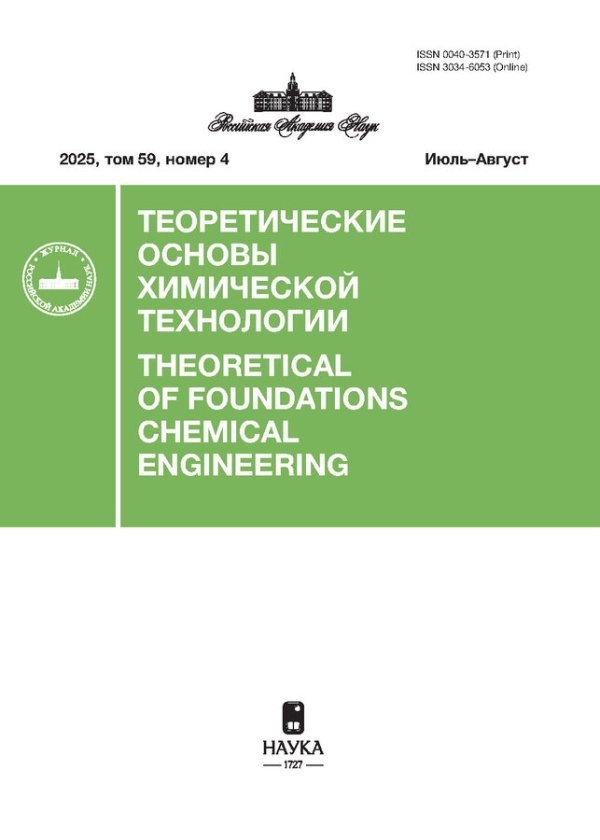Vol 57, No 2 (2023)
- Year: 2023
- Published: 01.03.2023
- Articles: 12
- URL: https://journals.rcsi.science/0040-3571/issue/view/7978
Full Issue
Articles
Optimal Organization of Complex Processes in Chemical Engineering Using General Systems Theory
Abstract
The organization of complex chemical-engineering systems (CESs) is optimized using the organism-based approach of general systems theory from the standpoint of information theory. It is shown that the organism-based approach makes it possible to write the problem of the optimal organization of a CES as a multilevel optimization procedure, which implies the coordinated functioning of the elements of the system at the macrolevel in conjunction with an increase in their efficiency at the microlevel. This allows to achieve synergistic effects in the system. Improving the organization of the CES objectively causes increases the macroscopicity or integrity of the system, as well its autonomy in terms of energy use. Organization criteria for designing new process solutions are presented, which characterize the optimal distribution of CES functions between elements and subsystems. The possibility of achieving synergistic indicators of energy efficiency was demonstrated in designing a new process for the removal of carbon dioxide from flue gases.
 141-150
141-150


Simulation of Purification of Lower Olefins in Pyrogas from Acetylene Hydrocarbons on Nickel Polymetallic Catalysts
Abstract
The kinetics of the reactions of selective hydrogenation of acetylenic hydrocarbons in ethane–ethylene and propane–propylene fractions (EEF and PPF) of pyrogas on a polymetallic nickel catalyst promoted with group I, III, IV, and VI metals is studied. The dimensions of the cylindrical granules used in the catalytic studies are 2 mm diameter and 10 mm length. The nickel content in the catalyst is less than 32 wt %. The kinetic experiments are carried out in a laboratory flow reactor 2 cm in diameter with a reaction-zone length of 20 cm and a bench reactor with an inner tube diameter of 3.2 cm and a reaction-zone length of 600 cm. Experimental conditions were varied as: feed flow rate of 2000–42000 h–1, reaction-zone temperature 330–410 K, pressure 1–30 atm, and hydrogen : acetylenic hydrocarbon molar ratio 2–10. A staged two-route mechanism for the reaction of hydrogenation of acetylenic hydrocarbons is proposed and a kinetic model corresponding to it is derived. A total of 80 experiments are carried out on laboratory and bench installations. The kinetic model constants and the macrokinetic constants of the bench reactor model are estimated by the nonlinear least-squares method. The correspondence of the proposed models to the experimental results is shown. The possibility of joint purification of EEF and PPF pyrogas in a single reactor with an increase in olefins in the product stream compared to the feed stream is demonstrated.
 151-165
151-165


Suspending Conditions for a Smooth-Wall Mixer
Abstract
Based on the known assumption about the predominant effect of dynamic velocity on the detachment of solid-phase particles from a bottom, the suspending condition for a smooth-wall mixer is proposed. The importance of experimental dynamic-velocity measurements for a certain industrial suspension is emphasized. It is shown that the intensive tangential flow of a mixed suspension should be taken into account when calculating the dynamic velocity. The equation for calculating the minimum stirrer rotation speed to exclude the formation of a sediment on the bottom of a mixer is proposed. The equation is experimentally verified for mixers of laboratory and industrial scales in the mixing of L : S systems.
 166-176
166-176


Effect of the Side-Stream Location and the Side-Stream Value on the Optimal Entrainer Flowrate in Thermally Coupled Extractive Distillation Columns
Abstract
The extractive distillation of three binary mixtures (acetone–chloroform, acetone–methanol, and allyl alcohol–allyl acetate) in traditional two-column schemes and in sequence with partially coupled heat and material flows is considered. The optimal scheme parameters according to the criterion of total energy costs in column boilers are determined. It is shown that the use of sequence with partially coupled heat and material flows provides energy cost savings of 4.4–29.2% compared to the traditional scheme. It is found that during the extractive distillation of the allyl alcohol–allyl acetate mixture, the optimal values of the extractive agent flowrate for the two-column scheme and the scheme with partially coupled heat and material flows coincide; the optimal flowrate of the extractive agent in the scheme with partially coupled heat and material flows in the separation of an acetone–chloroform mixture is 1.28 times lower, and in the separation of an acetone–methanol mixture, it is 1.27 times higher than in the two-column scheme. The reasons for these differences are established.
 177-187
177-187


Influence of Leachable Filler on Parameters of Porous Structure and Water Sorption with Polyvinyl Formal Filters
Abstract
The work presents data on the formation of a porous structure from polyvinyl formal (PVF) with a leachable filler (starch) during the chemical reaction of PVA acetalization. It is found that under optimal conditions for the synthesis of PVF, the introduction of starch in a given amount leads to an increase in total porosity from 58 to 84% and of open porosity from 36 to 78%. It is established that the minimum apparent density is 0.2 g cm–3 for PVF samples with starch and is achieved at a synthesis temperature of 60°C and a catalyst concentration of 40 vol %. The dependences of PVF water absorption on time, synthesis temperature, and catalyst concentration are given. It is established that water sorption reaches its maximum values of ~900% only with the introduction of a leachable filler (starch). The introduction of a leachable filler (starch) leads to an increase in water sorption by a factor of ~2 compared to PVF without starch, which makes it possible to obtain filters with a high efficiency in separating water from hydrocarbon fuels.
 188-193
188-193


Model of Extraction from a Pore into the Ambient Space
Abstract
The problem of extraction a target component from a cylindrical pore is studied. The solution of this problem is used as a basis for the mathematical model of mass transfer in a porous medium. The proposed model is applicable for the description of a number of processes, in particular, extraction and sediment washing. Some graphical illustrations explaining the process of washing within the proposed model are given.
 194-201
194-201


Relationship between Diffusion Coefficients in Nonideal Binary Lennard-Jones Mixtures and Entropy
Abstract
The simulation of nonideal Lennard-Jones mixtures is carried out by the method of molecular dynamics. The values of pressure, internal energy, chemical potential, and diffusion coefficients are determined depending on the composition and density. The nonideal behavior of the mixtures is specified by the parameters in the mixing rules for the intermolecular interaction potential. Four options for the values of such parameters are considered. The thermodynamic consistency of the calculated thermodynamic properties is verified using the Gibbs–Duhem expression. The value of excess entropy is calculated, and its connection with the Einstein diffusion coefficients is shown. A parameter is determined in the regression equation that relates the excess entropy to the Einstein diffusion coefficients. Its value is 0.8, which is close to the values in similar expressions for other substances.
 202-208
202-208


Surrogate Models of Hydrogen Oxidation Kinetics based on Deep Neural Networks
Abstract
The paper presents a data based surrogate model of the chemical kinetics of hydrogen oxidation by air using recurrent and feed-forward neural networks. The work aims at the application of surrogate models in computational fluid dynamics simulators, which are ubiquitous in the development and optimization of modern chemical technologies. The sensitivity of the results to the size of the data set and network parameters is analyzed. For a seven-component reaction mechanism at adiabatic conditions, a model trained on a sample of one million sets of initial conditions enables prediction of the dependence of concentrations and temperature on time with a standard deviation below 2% over 20 microsecond range. However, points with large deviations reaching 10% are also observed, mostly for minor components with low concentrations. The surrogate model is several times faster compared to the direct numerical solution of kinetic equations on the temporal grid. The computational performance strongly depends on the batch size and is sensitive to the hardware. The results of the work demonstrate a significant potential of machine learning methods for modeling chemical transformations in computational fluid dynamics solvers. Further improvement of the accuracy with a similar computational performance can be expected from: (a) separate models for short-time (that is, strongly non-equilibrium) and long-time (closer to the equilibrium) ranges; (b) repeated optimization of network parameters even with minor modifications of the reaction mechanism; (c) more versatile approaches to complying with the conservation laws (d) application of physics informed machine learning (e.g. of the models with additional physical and chemical constraints such as mass conservation).
 209-217
209-217


Concentration Distribution of Molecules and Other Species in the Model System Fe–NaCl–Na2S–H2SO4–H2O at Various Temperatures of the Electrocoagulation Process
Abstract
Under practical conditions, one of the possible solutions to the problem of treatment of hydrogen-sulfide-containing industrial wastewater is the electrochemical oxidation of sulfides. In this work, the model system Fe–NaCl–Na2S–H2SO4–H2O is considered, an experimental setup is constructed, and the electrocoagulation process is studied in a wide (288–308 K) range of temperatures of an aqueous solution of hydrogen sulfide. The optimal ratios between the initial components in the system are determined. The experimental and calculated pH of the solution are found. The system is thermodynamically modeled by minimizing the Gibbs energy, and the concentration distribution of individual molecules and other species (cations, anions) in the solution is characterized. Possible chemical reactions in the system Fe–NaCl–Na2S–H2SO4–H2O during the electrocoagulation of hydrogen-sulfide-containing wastewater are identified. Eh–pH diagrams are constructed to compare the redox potentials of the systems Fe–H2O, Fe–H2O–S, and Fe–NaCl–Na2S–H2SO4–H2O based on the determined concentrations of iron- and sulfur-containing particles in the solution. A calculation formula for the redox potential Eh of the system is obtained.
 218-227
218-227


Study of the Efficiency of Heat Transfer in a Stirred Tank with Nonuniform Movement of the Impeller
Abstract
Mixing is one of the most common processes in various branches of the chemical industry: food, construction, oil refining, pharmaceuticals, and others. Increasing the intensity of mixing can be achieved by changing the speed or direction of movement of the impeller, which is confirmed by studies of domestic and foreign authors. In this paper, a planetary drive of a stirred tank is considered, which makes it possible to implement various types of uneven movement of the impeller. The advantages of the proposed mechanism over existing analogues are compactness, reliability, and ease of setting the coefficient of uneven rotation of the agitator. On the basis of the IKA laboratory reactor, an experimental setup is constructed, with the help of which comparative tests of the heat-transfer intensity in a traditional mixing device with a constant rotational speed and using the proposed planetary mechanism are carried out. As a result of the experiment, it is found that the transmission to the impeller of uneven movement can reduce the mixing time, as well as increase the energy efficiency of the apparatus.
 228-237
228-237


Cases of Transformation of the Equations of Motion of an Incompressible Viscous Fluid into the Euler Equations
Abstract
In chemical technology, an important place is occupied by studies of the processes of mass and heat transfer in moving media. Obviously, in order to study these processes, it is necessary to know how the media move. Determining the velocity field of liquids and gases is a purely kinematic task. Can it be solved without resorting to the equations of motion, limited only by the continuity equation?
 238-244
238-244


С юбилеем доктора технических наук, профессора Лаптева Анатолия Григорьевича
 245-246
245-246












